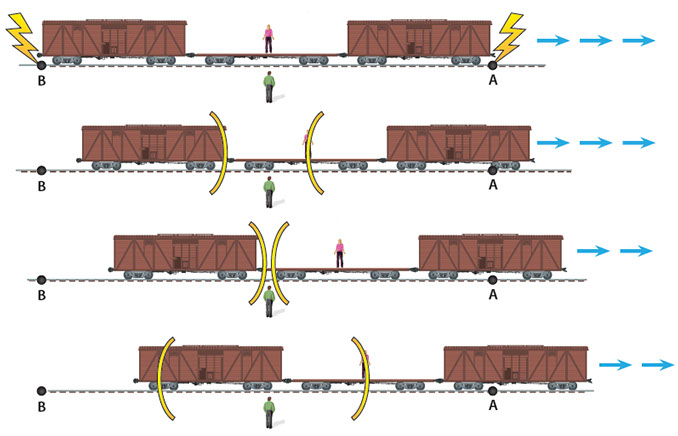-
WHAT IS NASA PHYSICS?
-
MODULES
-
Forces and Motion
-
Conservation of Momentum & Energy
-
Temperature and Heat
-
Fluids
-
Optics
-
Electromagnetic Spectrum
-
Modern Physics
-
Anticipation Guide 7
-
Intro to Modern Physics
-
Blackbody Radiation
-
The Ultraviolet Catastrophe
-
The Photoelectric Effect
-
Bohr's Atom
-
Spectra
-
Radioactive Decay
-
Special Relativity (SR)
-
Simultaneity
-
Distance and Time
-
General Relativity
-
May the Forces be with You
-
Modern Physics Notebook
-
Assessment Problems 7
-
-
Useful Things
-
-
SITE MAP
Modern Physics
-
Anticipation Guide
-
Intro to Modern Physics
-
Blackbody Radiation
-
The Ultraviolet Catastrophe
-
The Photoelectric Effect
-
Bohr's Atom
-
Spectra
-
Radioactive Decay
-
Special Relativity (SR)
-
Simultaneity
-
Distance and Time
-
General Relativity
-
May the Forces be with You
-
Notebook
-
Assessment Problems
Simultaneity
Imagine a woman in pink is standing on a flatcar in the middle of a fast moving train. A green-shirted man is standing directly in front of her by the side of the tracks. As the train passes directly in front of Mr. Green, lightning bolts simultaneously strike the track at the front (A) and the rear (B) of the train (top diagram). Because light does not travel infinitely fast, the light from the bolt at front of the train (A) takes a certain amount of time to travel towards Ms. Pink and Mr. Green. But the train is also moving to the right, carrying Ms. Pink towards the A bolt light so she will see it first (second diagram). Meanwhile light is traveling equally fast from A and B toward stationary Mr. Green so he will see both of them simultaneously (third diagram). The B bolt light will have to travel a little further to catch up to where Ms. Pink has been moved to, and she will see B after she saw A (bottom diagram).

Diagram modified from Rob Salgado, Syracuse University. (This is a very fast train!)
Mr. Green observes the lightning A and B at the same instant because he is stationary and the light from each bolt has the same distance to travel to reach him. However, for Ms. Pink the two lightning strikes are NOT simultaneous. Who is correct? SR says they are both correct for their frame of reference. In SR, there is no such thing as global simultaneity because there are different reference frames – the moving train or the stationary ground. It all depends on your frame of reference.
Here is a YouTube video that demonstrates this scenario.
© 2013 by Wheeling Jesuit University/Center for Educational Technologies®. 316 Washington Ave., Wheeling, WV 26003-6243. All rights reserved. Privacy Policy and Terms of Use.

